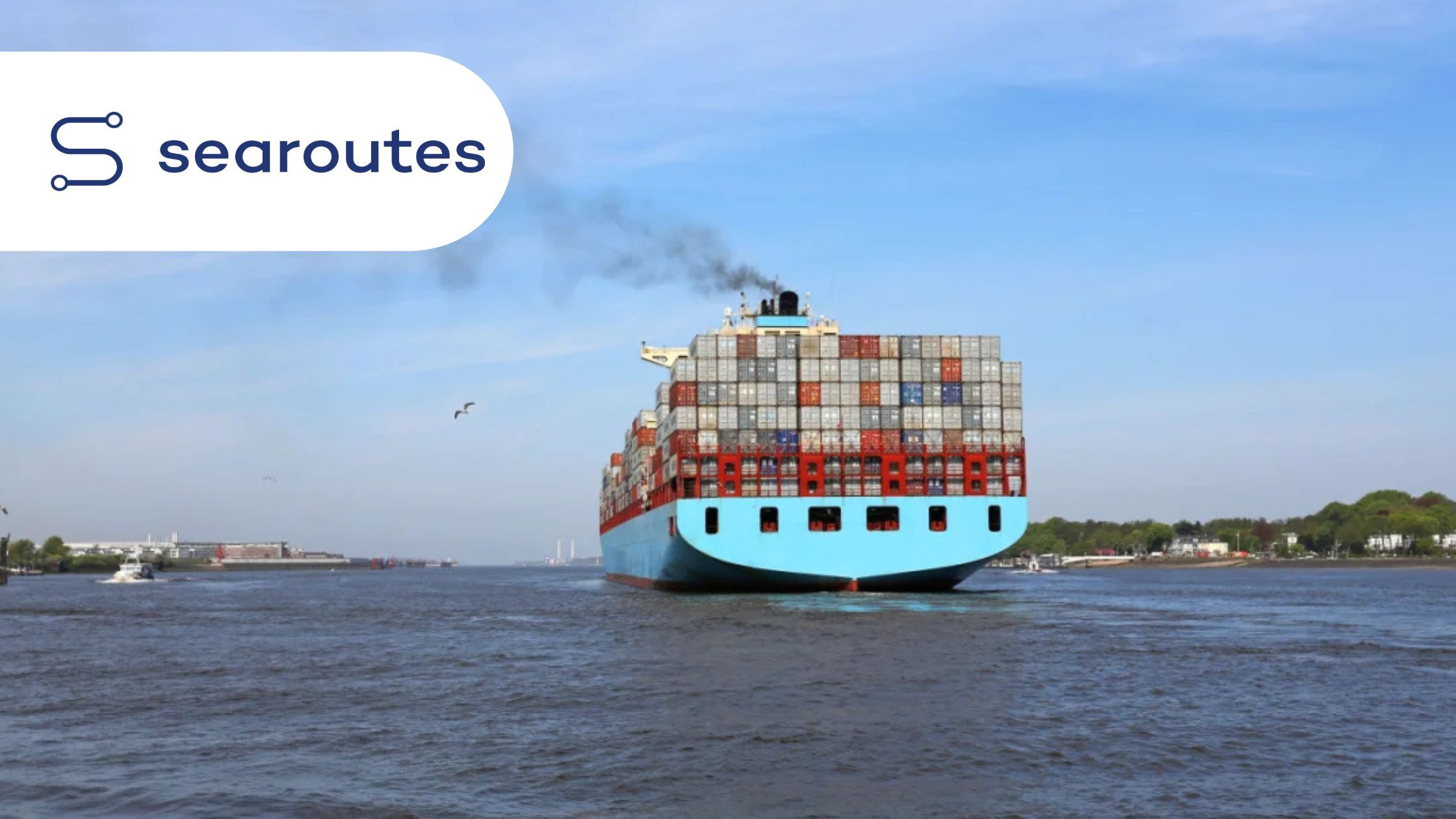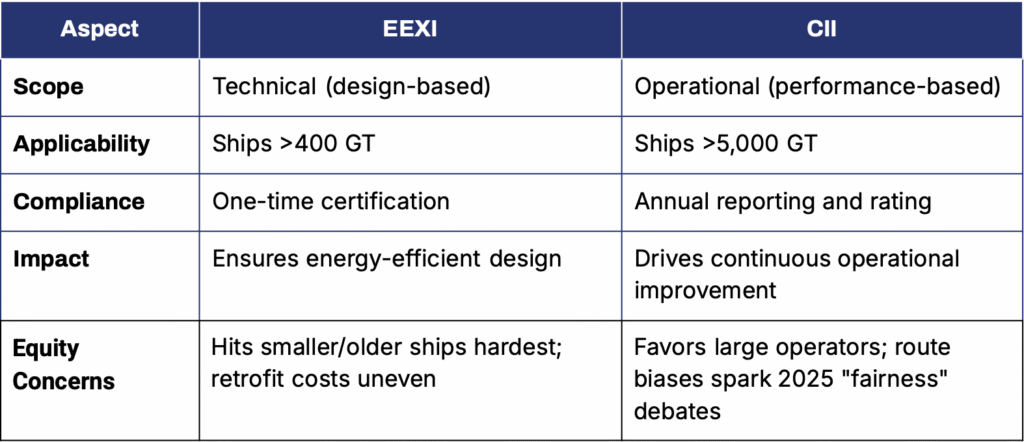
EEXI and CII: Guide to Shipping’s Sustainability Regulations with 2026 -2028 outlook
Introduction
The International Maritime Organization (IMO) has set ambitious targets to reduce shipping’s carbon emissions by 40% by 2030 and 70% by 2050, compared to 2008 levels. To achieve these goals, the IMO introduced two key regulations: the Energy Efficiency Existing Ship Index (EEXI) and the Carbon Intensity Indicator (CII). These measures are now in full effect, with ongoing updates and stricter requirements expected through 2028.
This guide explains what EEXI and CII are, their compliance requirements, and what shipowners and operators need to know for 2026–2028.
Definitions: EEXI and CII Explained
What is EEXI?
The Energy Efficiency Existing Ship Index (EEXI) is a technical measure that assesses the energy efficiency of existing ships over 400 gross tonnage (GT). It requires vessels to meet a specific energy efficiency baseline, calculated based on their design. Compliance is verified through a one-time certification process, and ships must have an approved EEXI technical file and a compliant EEXI value to receive an International Energy Efficiency Certificate (IEEC).
What is CII?
The Carbon Intensity Indicator (CII) measures the operational carbon intensity of ships over 5,000 GT. It quantifies annual CO₂ emissions per tonne-mile, rating vessels from A (best) to E (worst). Ships must achieve at least a C rating; those rated D for three consecutive years or E in any year must submit a corrective action plan.
Current Regulations and Compliance
EEXI Compliance
- Applicability: All existing ships over 400 GT;
- Requirements: Vessels must calculate their attained EEXI and ensure it meets the IMO’s required baseline. Non-compliance can result in operational restrictions or denial of certification;
- Certification: EEXI compliance is reflected in the ship’s IEEC, with verification conducted during annual, intermediate, or renewal surveys.
CII Compliance
- Applicability: All ships over 5,000 GT;
- Requirements: Annual reporting of operational carbon intensity, with ratings from A to E. Ships rated D for three years or E must implement a corrective action plan;
- Reduction targets: The required CII becomes more stringent each year, with annual improvement targets of approximately 2% until 2026. From 2027–2030, reduction factors will be set based on ongoing IMO reviews.
2026–2028 Outlook
EEXI
- Stability: EEXI requirements are stable, with no major changes expected. Compliance remains a one-time technical assessment, though ongoing monitoring is advised.
CII
- Stricter Targets: The IMO will review and likely increase the stringency of CII reduction factors. From 2027–2030, ships must achieve progressively lower carbon intensity, with specific targets to be finalized by 2026.
- Operational Impact: Ships will need to adopt advanced technologies, optimize routes, and improve energy efficiency to maintain compliance. Failure to meet targets may result in commercial disadvantages, such as higher port fees or restricted access.
Emerging Trend: Regulatory Synergies
As EEXI and CII mature, they’re increasingly intertwined with regional carbon markets. The EU ETS now covers 50% of voyages into/out of Europe, with full scope by 2026, while FuelEU Maritime imposes penalties on high-carbon fuels since 2025. Trendy industry chatter highlights “CII as a market signal”—vessels with strong ratings could qualify for ETS rebates or attract green financing. Shipowners should model combined impacts now, as IMO’s 2025 CII review (concluding early 2026) may tighten targets to harmonize with these, potentially slashing operational costs for proactive fleets by 10–15%.
Controversy Spotlight: The 2025 CII Stringency Fight
IMO’s spring 2025 review of CII targets ended in acrimony, with green advocates decrying the modest 2027–2030 reductions as insufficient for the 70% emissions cut by 2050. Industry pushback focused on economic hits—e.g., CII-driven slow steaming could add 5–10% to voyage times, inflating costs amid volatile fuel prices. As targets finalize by Q4 2025, expect volatility: proactive owners are piloting hybrid fuels to buffer risks, but delays in IMO alignment could deter $50B+ in global retrofit investments.
Key Differences: EEXI vs. CII

How to Ensure Compliance
- EEXI:
- Conduct a technical assessment and submit an EEXI technical file.
- Implement engine power limitations (EPL) or other technical upgrades if required.
- CII:
- Monitor and report annual carbon intensity.
- Optimize routes, reduce speeds, and adopt energy-saving technologies.
- Develop a corrective action plan if rated D or E.
Navigating Charter Risks:
With CII’s operational focus, 2025 has seen a spike in disputes over speed vs. rating—charterers demand despatch, owners prioritize compliance. To resolve the current situation, best practices may include BIMCO’s CII clauses in charter parties’ contracts. They feature performance-based CII incentives (e.g., bonuses for A/B ratings), driven by regulation, market demand, and ESG accountability.
Conclusion
EEXI and CII are central to the IMO’s strategy for reducing shipping emissions. While EEXI focuses on technical efficiency, CII drives continuous operational improvement. Shipowners must stay informed about evolving requirements, especially the stricter CII targets from 2026–2028, to avoid penalties and maintain competitive advantage.
For further guidance, consult IMO resources or accredited advisors to ensure your fleet remains compliant and sustainable.
How Searoutes can support vessel owners and Carriers ?
Searoutes has developed a series of advanced algorithms to compute the most efficient shipping routes, reducing fuel consumption, emissions, and transit time. The system accounts for all relevant ship and routing parameters to deliver concrete, scalable solutions for vessel owners and shipment carriers across all seas and trade lanes.
Check our White Paper on AI-powered voyage planning or get in touch with our Sales team for more details.
Carbon accounting maritime industry, eexi and cii, shipping regulations, Standards & Framework